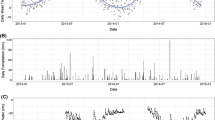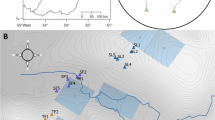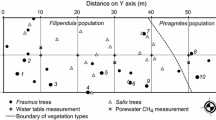Abstract
Aims
Methane (CH4) and nitrous oxide (N2O) fluxes from tree stems are still poorly quantified in temperate floodplain forests.
Methods
Methane and N2O fluxes were repeatedly measured at 0.3, 1.6 and 3.6 m stem height at three sites along a landscape gradient ranging from non-flooded to frequently flooded forest sites. The non-flooded forest was dominated by Fraxinus excelsior and the infrequently and frequently flooded sites by Populus alba.
Results
Stem surfaces were net CH4 and N2O sources at all sites. The CH4 source strength increased towards the wetter sites (non-flooded 2.51±12.71, infrequently-flooded 5.2±17.26, and frequently-flooded 11.15±24.04 μg-C-m−2 h−1), but flooding had no immanent effects on CH4 and N2O fluxes. Methane fluxes from poplar stems were highest at the stem base (0.3 m) and decreased with increasing measurement height. Methane fluxes from ash stems were lowest at the stem base and gradually increased until 3.6 m height. Nitrous oxide fluxes were low and did not show clear spatial patterns. The presence of mosses had no significant effects on CH4 and N2O fluxes.
Conclusions
Stem fluxes were small when compared to the corresponding soil fluxes at the non-flooded and infrequently flooded site, but significantly reduced the soil CH4 sink capacity at the frequently-flooded site. Methane flux strongly varied between 0.3 and 3.6 m stem height and showed distinctive tree species specific patterns. Our results therefore suggest that measuring at more than a single location near the stem base is inevitable to obtain any reliable CH4 or N2O flux estimate of a whole tree stem.



Similar content being viewed by others
References
Barba J, Bradford MA, Brewer PE et al (2019) Methane emissions from tree stems: a new frontier in the global carbon cycle. The New phytologist 222:18–28. https://doi.org/10.1111/nph.15582
Bates D, Mächler M, Bolker B, Walker S (2015) Fitting linear mixed-effects models using lme4. J Stat Soft 67. https://doi.org/10.18637/jss.v067.i01
Butterbach-Bahl K, Kiese R, Liu C (2011) Measurements of biosphere-atmosphere exchange of CH4 in terrestrial ecosystems. Methods in enzymology 495:271–287. https://doi.org/10.1016/B978-0-12-386905-0.00018-8
Butterbach-Bahl K, Baggs EM, Dannenmann M et al (2013) Nitrous oxide emissions from soils: how well do we understand the processes and their controls? Philosophical transactions of the Royal Society of London Series B, Biological sciences 368:20130122. https://doi.org/10.1098/rstb.2013.0122
Colmer TD (2003) Long-distance transport of gases in plants: a perspective on internal aeration and radial oxygen loss from roots. Plant Cell Environ 26:17–36. https://doi.org/10.1046/j.1365-3040.2003.00846.x
Covey KR, Megonigal JP (2019) Methane production and emissions in trees and forests. The New phytologist 222:35–51. https://doi.org/10.1111/nph.15624
Covey KR, Wood SA, Warren RJ et al (2012) Elevated methane concentrations in trees of an non-flooded forest. Geophys Res Lett 39:198. https://doi.org/10.1029/2012GL052361
Díaz-Pinés E, Heras P, Gasche R et al (2016) Nitrous oxide emissions from stems of ash (Fraxinus angustifolia Vahl) and European beech (Fagus sylvatica L.). Plant Soil 398:35–45. https://doi.org/10.1007/s11104-015-2629-8
Gauci V, Gowing DJG, Hornibrook ERC et al (2010) Woody stem methane emission in mature wetland alder trees. Atmospheric Environment 44:2157–2160. https://doi.org/10.1016/j.atmosenv.2010.02.034
Glenz C, Schlaepfer R, Lorgulescu I, Kienast F (2006) Flooding tolerance of Central European tree and shrub species. Forest Ecology and Management 235:1–13. https://doi.org/10.1016/j.foreco.2006.05.065
Halmschlager E, Kirisits T (2008) First report of the ash dieback pathogen Chalara fraxinea on Fraxinus excelsior in Austria. Plant Pathol 57:–1177. https://doi.org/10.1111/j.1365-3059.2008.01924.x
IPCC (2013) Summary for Policymakers. In: Climate Change 2013: The Physical Science Basis. Contribution of Working Group I to the Fifth Assessment Report of the Intergovernmental Panel on Climate Change [Stocker TF, Qin D, Plattner G-K, Tignor M, Allen SK, Boschung J, Nauels A, Xia Y, Bex V, Midgley PM (eds)]. Cambridge University Press, Cambridge, United Kingdom and New York, NY, USA
IUSS Working Group WRB (2015) World Reference Base for Soil Resources 2014, update 2015 International soil classification system for naming soils and creating legends for soil maps. In: World Soil Resources Reports No. 106. FAO, Rome. Available via http://www.fao.org/3/i3794en/I3794EN.pdf. Accessed 9 Nov 2020
Jeffrey LC, Maher DT, Tait DR, Johnston SG (2020) A small nimble in situ fine-scale flux method for measuring tree stem greenhouse gas emissions and processes (S.N.I.F.F). Ecosystems. https://doi.org/10.1007/s10021-020-00496-6
Kandel TP, Lærke PE, Hoffmann CC, Elsgaard L (2018) Complete annual CO2 , CH4 , and N2O balance of a temperate riparian wetland 12 years after rewetting. Ecological Engineering 127:527–535. https://doi.org/10.1016/j.ecoleng.2017.12.019
Keppler F, Hamilton JTG, Brass M, Röckmann T (2006) Methane emissions from terrestrial plants under aerobic conditions. Nature 439:187–191. https://doi.org/10.1038/nature04420
Kerr G (1998) A review of black heart of ash ( Fraxinus excelsior L.). Forestry 71:49–56. https://doi.org/10.1093/forestry/71.1.49
Krause S, Lewandowski J, Grimm NB et al (2017) Ecohydrological interfaces as hot spots of ecosystem processes. Water Resour Res 53:6359–6376. https://doi.org/10.1002/2016WR019516
Lenhart K, Weber B, Elbert W et al (2015) Nitrous oxide and methane emissions from cryptogamic covers. Glob Change Biol 21:3889–3900. https://doi.org/10.1111/gcb.12995
Lenhart K, Behrendt T, Greiner S, et al (2018) Nitrous oxide effluxes from plants as a potentially important source to the atmosphere. The New phytologist 221:1398–1408. https://doi.org/10.1111/nph.15455
Lenz H, Straßer L, Petercord R (2019) Eschentriebsterben: Biologie und Behandlung. In: LWF-Merkblatt 28. Available via http://www.lwf.bayern.de/mam/cms04/waldschutz/dateien/mb28-eschentriebsterben_2019_bf.pdf. Accessed 9 Nov 2020
Machacova K, Papen H, Kreuzwieser J, Rennenberg H (2013) Inundation strongly stimulates nitrous oxide emissions from stems of the non-flooded tree Fagus sylvatica and the riparian tree Alnus glutinosa. Plant Soil 364:287–301. https://doi.org/10.1007/s11104-012-1359-4
Machacova K, Bäck J, Vanhatalo A et al (2016) Pinus sylvestris as a missing source of nitrous oxide and methane in boreal forest. Sci Rep 6:23410. https://doi.org/10.1038/srep23410
Machacova K, Maier M, Svobodova K et al (2017) Cryptogamic stem covers may contribute to nitrous oxide consumption by mature beech trees. Sci Rep 7:13243. https://doi.org/10.1038/s41598-017-13781-7
Machacova K, Vainio E, Urban O, Pihlatie M (2019) Seasonal dynamics of stem N2O exchange follow the physiological activity of boreal trees. Nat Commun 10:4989. https://doi.org/10.1038/s41467-019-12976-y
Maier M, Machacova K, Lang F et al (2018) Combining soil and tree-stem flux measurements and soil gas profiles to understand CH 4 pathways in Fagus sylvatica forests. Z Pflanzenernähr Bodenk 181:31–35. https://doi.org/10.1002/jpln.201600405
Messenger DJ, McLeod AR, Fry SC (2009) Reactive oxygen species in aerobic methane formation from vegetation. Plant Signaling & Behavior 4:629–630. https://doi.org/10.4161/psb.4.7.8968
Nationalpark Donau-Auen GmbH (2018) Zahlen, Daten, Fakten. In: Der Nationalpark. Available via https://www.donauauen.at/der-nationalpark/zahlen-daten-fakten. Accessed 28 Feb 2020
Pangala SR, Moore S, Hornibrook ERC, Gauci V (2013) Trees are major conduits for methane egress from tropical forested wetlands. The New phytologist 197:524–531. https://doi.org/10.1111/nph.12031
Pangala SR, Hornibrook ERC, Gowing DJ, Gauci V (2015) The contribution of trees to ecosystem methane emissions in a temperate forested wetland. Global change biology 21:2642–2654. https://doi.org/10.1111/gcb.12891
Pangala SR, Enrich-Prast A, Basso LS, et al (2017) Large emissions from floodplain trees close the Amazon methane budget. Nature 552:230–234. https://doi.org/10.1038/nature24639
Parkin TB, Venterea RT, Hargreaves SK (2012) Calculating the detection limits of chamber-based soil greenhouse gas flux measurements. Journal of Environmental Quality 41:705–715. https://doi.org/10.2134/jeq2011.0394
Pitz S, Megonigal JP (2017) Temperate forest methane sink diminished by tree emissions. The New phytologist 214:1432–1439. https://doi.org/10.1111/nph.14559
Pitz SL, Megonigal JP, Chang C-H, Szlavecz K (2018) Methane fluxes from tree stems and soils along a habitat gradient. Biogeochemistry 137:307–320. https://doi.org/10.1007/s10533-017-0400-3
R Core Team (2017) R: A language and environment for statistical computing. In: R Foundation for Statistical Computing. Available via https://www.R-project.org. Accessed 1 Jan 2020
Rusch H, Renneberg H (1998) Black alder (Alnus glutinosa (L.) Gaertn.) trees mediate methane and nitrous oxide emission from the soil to the atmosphere. Plant and Soil 201:1–7. https://doi.org/10.1023/A:1004331521059
Schindler T, Mander Ü, Machacova K, et al (2020) Short-term flooding increases CH4 and N2O emissions from trees in a riparian forest soil-stem continuum. Sci Rep 10:3204. https://doi.org/10.1038/s41598-020-60058-7
Shrestha J, Niklaus PA, Frossard E et al (2012) Soil nitrogen dynamics in a river floodplain mosaic. Journal of environmental quality 41:2033–2045. https://doi.org/10.2134/jeq2012.0059
Siegenthaler A, Welch B, Pangala SR, et al (2016) Technical Note: Semi-rigid chambers for methane gas flux measurements on tree stems. Biogeosciences 13:1197–1207. https://doi.org/10.5194/bg-13-1197-2016
Smith KA, Ball T, Conen F et al (2018) Exchange of greenhouse gases between soil and atmosphere: interactions of soil physical factors and biological processes. Eur J Soil Sci 69:10–20. https://doi.org/10.1111/ejss.12539
Sundqvist E, Crill P, Mölder M, Vestin P, Lindroth A (2012) Atmospheric methane removal by boreal plants. Geophys Res Lett 39:L21806. https://doi.org/10.1029/2012GL053592
Terazawa K, Ishizuka S, Sakata T, et al (2007) Methane emissions from stems of Fraxinus mandshurica var. japonica trees in a floodplain forest. Soil Biology and Biochemistry 39:2689–2692. https://doi.org/10.1016/j.soilbio.2007.05.013
Tockner K, Stanford JA (2002) Riverine flood plains: present state and future trends. Envir Conserv 29:308–330. https://doi.org/10.1017/S037689290200022X
Topp E, Pattey E (1997) Soils as sources and sinks for atmospheric methane. Can J Soil Sci 77:167–177. https://doi.org/10.4141/S96-107
Wang Z-P, Gu Q, Deng F-D, et al (2016) Methane emissions from the trunks of living trees on non-flooded soils. The New phytologist 211:429–439. https://doi.org/10.1111/nph.13909
Wang Z-P, Han S-J, Li H-L et al (2017) Methane Production Explained Largely by Water Content in the Heartwood of Living Trees in Non-flooded Forests. J Geophys Res Biogeosci 122:2479–2489. https://doi.org/10.1002/2017jg003991
Warner DL, Villarreal S, McWilliams K et al (2017) Carbon Dioxide and Methane Fluxes From Tree Stems, Coarse Woody Debris, and Soils in an Non-flooded Temperate Forest. Ecosystems 20:1205–1216. https://doi.org/10.1007/s10021-016-0106-8
Welch B, Gauci V, Sayer EJ (2019) Tree stem bases are sources of CH4 and N2 O in a tropical forest on non-flooded soil during the dry to wet season transition. Global Change Biol 25:361–372. https://doi.org/10.1111/gcb.14498
Wen Y, Corre MD, Rachow C et al (2017) Nitrous oxide emissions from stems of alder, beech and spruce in a temperate forest. Plant Soil 420:423–434. https://doi.org/10.1007/s11104-017-3416-5
Wickham H (2009) Ggplot2: elegant graphics for data analysis. Springer, New York
Yip DZ, Veach AM, Yang ZK, et al (2018) Methanogenic Archaea dominate mature heartwood habitats of Eastern Cottonwood (Populus deltoides). The New phytologist 222: 115–121 https://doi.org/10.1111/nph.15346
Zentralanstalt für Meteorologie und Geodynamik (2020) Klimaforschung. Available via https://www.zamg.ac.at/cms/de/klima/klimaforschung. Accessed 28 Feb 2020
Acknowledgements
The study was funded by the Austrian Klima- und Energie Fonds (ACRP9 project FloodFlux, KR16AC0K13382) The contributions of Katerina Machacova and Thomas Schindler were supported by the Czech Science Foundation (17-18112Y), the Ministry of Education, Youth and Sports of the Czech Republic within the National Sustainability Program I (grant number LO1415)) and the project SustES - Adaptation strategies for sustainable ecosystem services and food security under adverse environmental conditions (CZ.02.1.01/0.0/0.0/16_019/0000797). We thank Leszek Dariusz Laptaszyński for technical support during chamber installation, Michaela Djordjevic and Armin Hofbauer for support in the GC lab as well as Günther Gollobich and Katarina Stefaner for their support during field work. We thank the national park authorities for their generous support.
Author information
Authors and Affiliations
Contributions
AS designed and planned the research. EM analyzed the data and wrote the first draft of the manuscript. EM and AS performed the measurements. AS, KM, EM installed the stem chambers. BK supervised gas chromatography data management. TS and KM contributed to measurements during the flooding campaign. All authors contributed to the writing of the manuscript.
Corresponding author
Additional information
Responsible Editor: Paul Bodelier
Publisher’s note
Springer Nature remains neutral with regard to jurisdictional claims in published maps and institutional affiliations.
Supplementary Information
ESM 1
(DOCX 533 kb)
Rights and permissions
About this article
Cite this article
Moldaschl, E., Kitzler, B., Machacova, K. et al. Stem CH4 and N2O fluxes of Fraxinus excelsior and Populus alba trees along a flooding gradient. Plant Soil 461, 407–420 (2021). https://doi.org/10.1007/s11104-020-04818-4
Received:
Accepted:
Published:
Issue Date:
DOI: https://doi.org/10.1007/s11104-020-04818-4




